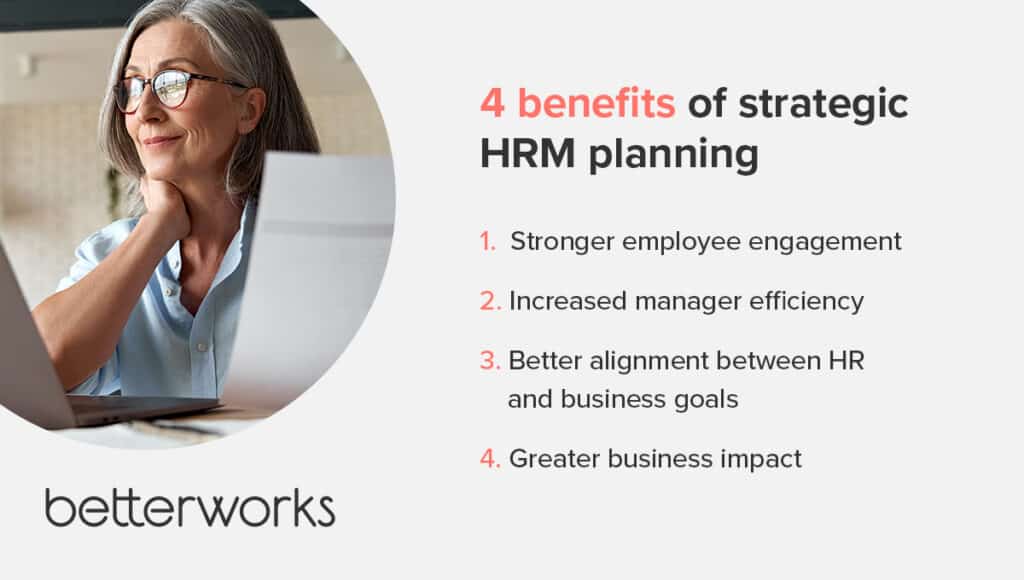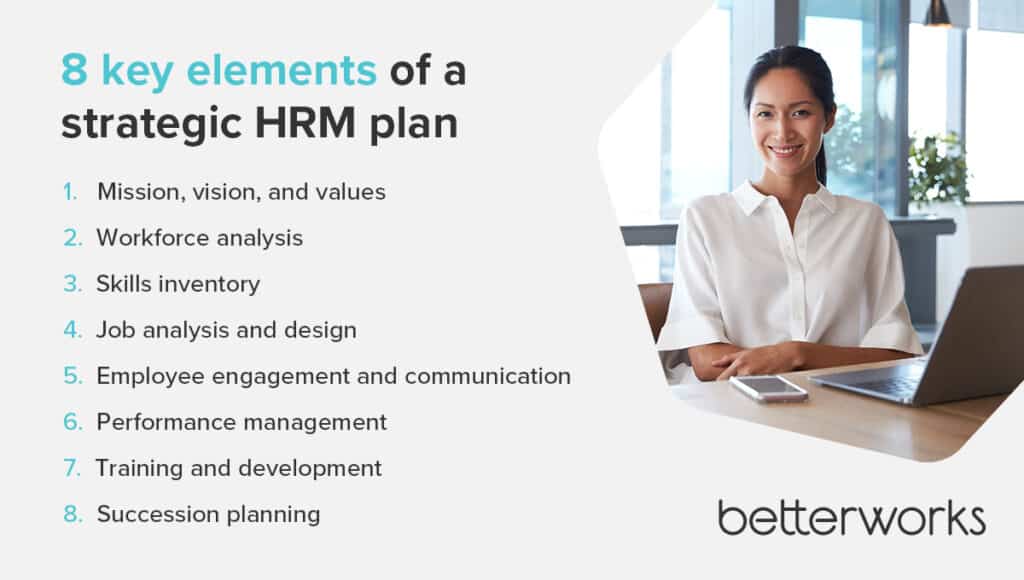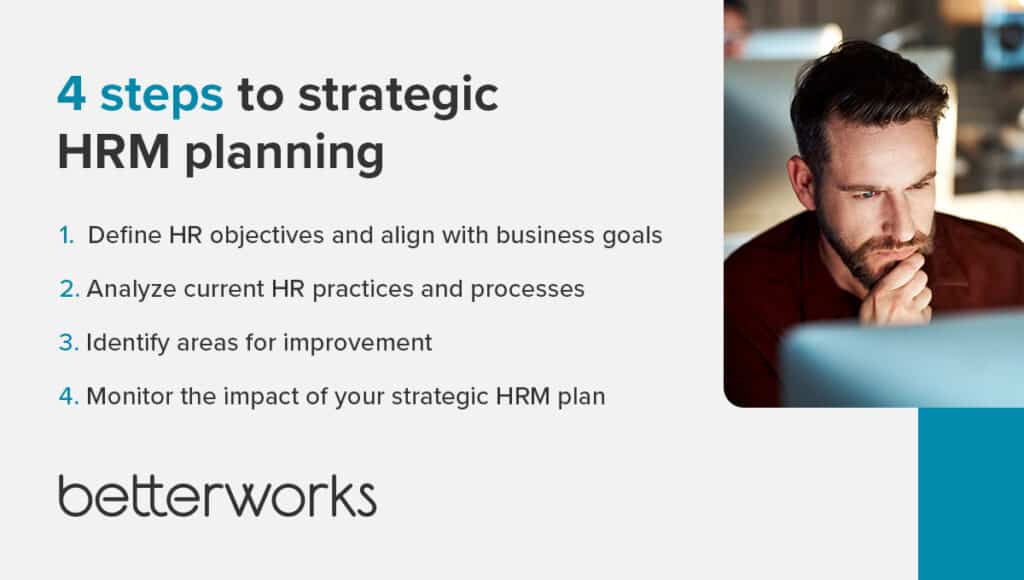Today’s HR leaders are under tremendous pressure to optimize their workforces for today’s demands while building agility for the future. To bring this new model to life, you need a strategic HRM plan that outlines how people will find their full potential within your organization.
According to a recent report from the HR Research Institute, only 8% of business leaders strongly agree that their workforce and business are prepared to adapt to changing work trends, while 42% don’t agree at all. Preparing your workforce to meet business needs today and in the future requires more strategic use of your talent resources — and a modern HRM plan can help you get there.
Learn more about what a comprehensive strategic HRM plan looks like, the benefits of a modern one, and steps to take to strengthen yours.
What is a strategic HRM plan?
A strategic HRM plan is a comprehensive document outlining an organization’s HR goals, objectives, and strategies. Such a plan compares business goals against the people resources needed to accomplish them, including the skills, abilities, traits, talents, and competencies housed within your workforce.
The plan should include a detailed overview of the organization’s HR goals and how they link to business objectives. It should also analyze the current environment, review applicable policies and procedures, and offer a road map for implementing and managing HRM initiatives. Additionally, the plan should address how the organization will measure and track progress.
Strategic HRM planning lives at a higher level than operational HR planning, which takes a more tactical approach. Strategic HRM planning sets aspirational, ambitious goals based on the company’s vision. Generally, a strategic HRM plan guides operational HR planning, which builds the long-term plan into daily operations and processes.
Why do organizations need a strategic HRM plan?
A strategic HRM plan details the resources needed by the business — including by departments and teams — to achieve objectives. It also specifies what actions to take to identify and fill gaps. Without an HRM plan, an organization might begin an ambitious project only to discover halfway through that the workforce doesn’t have the skills needed to deliver.
Ultimately, an HRM plan helps businesses understand what human resources they have and how to maximize their value. These plans balance available resources against demand and factor in upcoming initiatives and goals to ensure the right skills, abilities, and competencies are available when needed.
4 benefits of strategic HRM planning
HRM planning provides a line of sight into your workforce’s strengths and weaknesses and outlines your plans to sustainably develop your people in line with business objectives. Strategically deploying people where they’ll have the greatest impact produces several benefits for the workforce and the business.
Stronger employee engagement
Strategic HRM planning improves employee engagement by creating an inherently motivating environment for employees. When all projects and teams are adequately staffed, and people have the skills and abilities they need to succeed, they work more effectively. Doing better work helps employees feel a greater sense of progress and satisfaction, which often drives higher engagement.
An effective strategic HRM plan takes each employee’s strongest skills into account. To maximize value, it places workers in situations where they do their best work, which can be especially motivating. Moreover, people tend to enjoy doing work they’re good at, which supports higher employee satisfaction and engagement.
Increased manager efficiency
Strategic HRM planning can make a manager’s job easier by matching people’s skill sets with job assignments that make sense. A strong job fit helps people contribute to the team’s goals. When everyone is engaged and empowered to do their best work, the entire team’s efficiency increases.
A strategic HRM plan also serves as a tool for training managers to learn to allocate their team resources more effectively. By seeing the skills, abilities, and competencies available on their team, managers learn how to delegate tasks effectively over time.
Better alignment between HR and business goals
Strategic HRM planning is a living example of how the HR teams’ goals connect with business goals. These plans demonstrate how you’ll overcome HR challenges while keeping strategic goals top of mind. They outline how HR leaders will deploy people resources strategically to best support what the business wants to accomplish.
If one of your business goals is to improve product quality, for example, your HRM plan may include developing a new training program for product testers.
Greater business impact
Strategic HRM planning helps HR leaders (and other executives) more easily grasp the landscape of the organization’s available people resources. This knowledge informs decisions around reallocating talent, improving operational efficiency, and increasing customer satisfaction.

8 key elements of a strategic HRM plan
Every strategic HRM plan differs based on the needs of the business. As you create a strategic HR plan, consider these eight essential elements.
Mission, vision, and values statement
Your organization’s mission statement provides a framework for decision-making and goal-setting. Your vision statement states long-term goals at a high level and can be a guide for setting objectives.
These statements provide a North Star for HRM planning. For example, your mission and vision statement should already inform how you recruit, train, and build company culture. By looking at them through a strategic lens, these statements help you identify the skills, values, and traits you need to achieve business goals.
Workforce analysis
A workforce analysis is a crucial exercise for understanding your current state. Going through this process means looking at the existing workforce’s skills, knowledge, and experience and the projected business needs. The analysis helps identify gaps between current and future workforce requirements and guides recruitment, training, retention, and succession planning decisions.
Equipped with this information, you can make more informed decisions about allocating resources in the near and long term.
Skills inventory
Skills inventories allow you to identify and assess workforce competencies, providing a better understanding of your human resources. Use this information to develop strategies tailored to the strengths and weaknesses of your workforce.
For example, if the skills inventory reveals a lack of technical expertise in a certain area, you can create training programs to fill the gap or emphasize hiring people with this skill set.
Job analysis and design
Job analysis exercises affect strategic HRM planning by providing valuable information about organizational staffing. This process identifies each job’s duties, tasks, responsibilities, and required skills and knowledge. When HR leaders understand job architectures, they can properly update job descriptions.
Employee engagement and communication
Like any strategy, an HRM plan needs to be communicated to managers and front-line employees. Make sure they understand their responsibilities and the potential benefits.
Some employees might worry that an HRM plan reduces their value to what the business can get from them. But strategic HRM planning allows team members to exercise their strongest talents and develop new ones. Emphasize communication that explains how HRM planning helps employees reach their full potential.
Performance management
Performance management is a framework for aligning individual goals and objectives with those of the organization. This provides strategic value by guaranteeing that everyone in the company is working to achieve aligned goals.
The data gathered from performance management software and processes helps HR identify skill gaps, evaluate workforce performance and career aspirations, and gauge progress toward goals. You can use this data to refine existing goals and inform performance improvement plans.
Training and development
Training and employee development are important components of a strategic HRM plan. Training keeps employees up to date with the latest industry trends, technology, and procedures, which improves operations and efficiency.
Employee development is more strategic — increasing employee skills and expertise for the long term. This approach helps team members explore their career path, including the education they need to advance.
Succession planning
Succession planning is the process of identifying and developing potential leaders to fill critical positions. Strategic HRM planning recognizes this importance by identifying what roles are most important to fill quickly — and which roles are at risk of not having a successor ready.
Succession plans help companies ensure that internal candidates can fill any key vacancy with the skills and knowledge to maintain business continuity and achieve strategic objectives.

4 steps for strategic HRM planning
Like any HR initiative, you need a sound approach. Here are four steps for creating an HRM plan, with examples, at your organization.
Define HR objectives and align with business goals
The HRM plan always takes its cue from the larger business plan. To create a strategic HRM plan, start by evaluating the organization’s goals and objectives. Next, assess the results of your workforce analysis and skills inventory and compare them against the needs of the business plan. Identify places where resources are low, and draw up plans to close the gaps.
Work with executive-level peers to identify HR-specific needs that will help them execute the business plan. At this stage, flag any strategic actions the organization lacks the resources to accomplish.
Your HRM plan, for example, comes into play if the chief risk officer wants to adopt new risk management software within the quarter. You might push back against such a tight timeline if you lack the capacity to gain buy-in, communicate the transition plan, and train people on new processes.
Distill your HR objectives into a measurable, achievable HRM plan. Break down the plan’s goals into objectives and key results, and assign accountability and ownership for each smaller objective to ensure they’re accomplished.
Analyze current HR practices and processes
Don’t assume your existing processes make sense for tomorrow’s business goals. Start by evaluating HR policies, procedures, and systems. Are they the right fit for producing the outcomes you need? How could they be improved, refined, or redefined?
If the business is focused on long-term continuity, for example, it needs a more resilient workforce. For HR leaders, that means they might look at the organization’s traditionally linear career paths. They might discover knowledge silos and higher turnover among employees who don’t see a path upward. A strategic HRM plan that emphasizes open and lateral career paths can break down silos so everyone has better visibility into other parts of the business and help employees see a future within the organization — both of which contribute to business continuity.
Identify areas for improvement and implement changes
One of the most important steps of HRM planning is plotting the actions you’ll take to close resource gaps. Doing so often requires changing processes or workflows. Include a timeline for implementing changes and a detailed budget.
For example, a business traditionally hires contractors where your workforce lacks the requisite skill sets. But as the business evolves, you see an opportunity to build out those capabilities in-house — either by upskilling employees or hiring from the outside. A strategic HRM plan lays out the reasoning for this shift in spending, hiring, and structure.
Monitor and evaluate the impact of your strategic HRM plan
All strategic HR plans need to be monitored. If the plan isn’t progressing or doing so quickly enough, take a step back to assess why.
Perhaps the HRM plan intended to fill skills gaps through external recruiting and hiring. But if those skills aren’t readily available or come at a premium cost, you might have to pivot to internal skills development.

The future of strategic HRM planning
The future of strategic HRM planning increasingly intersects with technology, analytics, and data. Companies want data-driven approaches to everything in business, including talent.
Automation and artificial intelligence are already commonplace in transactional areas of HR, such as recruitment, training, and onboarding. These technologies will gain ground in more strategic areas, such as interpreting key HR metrics. The more you understand your HR data, the more effectively you can deploy talent to support the business.
Companies are also looking for a more holistic approach to HR management and greater emphasis on employee engagement and well-being. Employees are reprioritizing their responsibilities, increasingly demanding flexibility and better benefits. Strategic HRM plans need to respond to these trends, both in terms of organizational design and the allocation of people resources.
Amplify HR’s value with a strategic HRM plan
The importance of having a strategic HRM plan can’t be overstated. Proactive resource planning by HR leaders ensures that the business has the skills, abilities, and competencies needed to achieve strategic objectives.
HR leaders increasingly have a seat at the table. Your HRM plan is how you showcase your value, build a successful and sustainable workforce, and help the organization reap the rewards.
Want to learn more about strategic HR?


